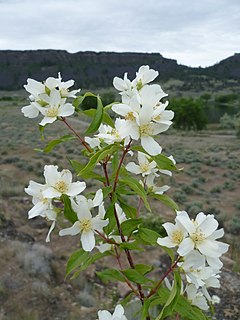
Philadelphus lewisii, the Lewis' mock-orange, mock-orange, Gordon's mockorange, wild mockorange,Indian arrowwood, or syringa, is a deciduous shrub native to western North America, and is the state flower of Idaho.

Muehlenbeckia or maidenhair is a genus of flowering plants in the family Polygonaceae. It is native to the borders of the Pacific, including South and North America, Papua New Guinea and Australasia. It has been introduced elsewhere, including Europe. Species vary in their growth habits, many being vines or shrubs. In some environments, rampant species can become weedy and difficult to eradicate.

Artemisia californica, also known as California sagebrush, is a species of western North American shrub in the sunflower family.

Hakea bucculenta, commonly known as red pokers, is a large shrub in the family Proteaceae endemic to Western Australia. A spectacular ornamental shrub with red or orange flowers that appear in rod-like blooms in leaf axils for an extended period from May to November.
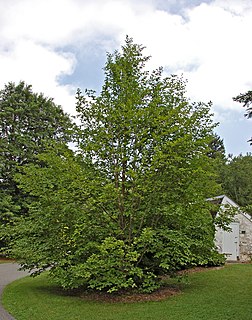
Stewartia pseudocamellia, also known as Korean stewartia, Japanese stewartia, or deciduous camellia, is a species of flowering plant in the family Theaceae, native to Japan and Korea.
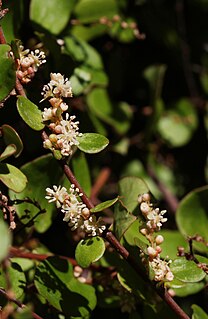
Muehlenbeckia complexa, commonly known as pōhuehue, although this name also applies to some other climbers such as Muehlenbeckia australis.
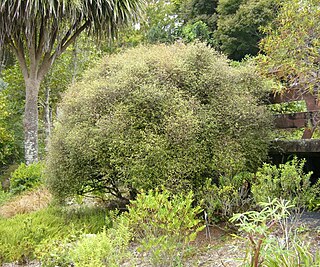
Muehlenbeckia astonii or shrubby tororaro is an endemic New Zealand shrub in the family Polygonaceae. It has distinctive small heart-shaped deciduous leaves amidst a tangle of wiry interlocking branches. Although common in cultivation around the world, it is extremely rare and threatened in the wild.

Hakea nodosa, commonly known as yellow hakea, is a shrub that is endemic to Australia. It usually has golden yellow flowers in profusion and needle-shaped leaves.

Protea aristata is a compact shrub with beautiful flowers which is endemic to the southwestern part of the Cape Region of South Africa. P. aristata has become one of South Africa's most famous proteas in spite of its relatively late discovery, and re-discovery in 1953. The leaves are soft, dense and needle-like and the flower heads are a stunning crimson red, it may thus be a good potential ornamental plant for South African gardens. It is usually called the Ladismith sugarbush in South African English, although it has been called pine sugar bush in Australia. In the Afrikaans language it has the vernacular name of klein-den-suikerbos.

Protea coronata is an erect shrub usually growing 2–3 m tall, but known to reach 5 m (16 ft). It produces an apple-green flower head and lanceolate leaves, turning purple-green around the flowerhead. Its stems are hairy. It flowers between April and September. The plant grows in dense stands on heavy clay soils in the Western Cape, South Africa, as well as the van Stadens region of the Eastern Cape.

Hakea platysperma, commonly known as the cricket ball hakea, is a shrub in the family Proteaceae. It has long, sharply pointed, needle-shaped leaves and fragrant cream-reddish flowers in clusters from July to October. It is endemic to the south west of Western Australia.
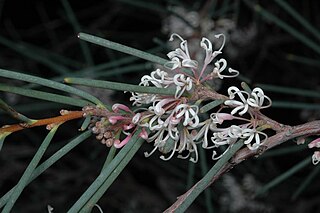
Hakea cycloptera, commonly known as elm-seed hakea, is a shrub in the family Proteaceae endemic to South Australia. It is a small spreading shrub with an abundance of pale pink or white flowers from December to August.

Muehlenbeckia axillaris is a low evergreen shrub, forming wiry mats up to about 1 metre in diameter, native to New Zealand, and the Australian states of Tasmania, New South Wales and Victoria. It has thin, red-brown stems, with glossy squarish to roundish leaves that are less than 1 cm (0.39 in) in diameter and 2–4 mm (0.079–0.157 in) thick. Flowers are inconspicuous, yellowish-white, 4–8 mm (0.16–0.31 in) in diameter, and borne in groups of up to three in the axils. The fruit is black, shiny, and up to 3.5 mm (0.14 in) long, produced in late summer to fall.
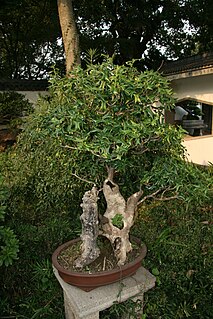
Ilex cornuta, commonly known as Chinese holly or horned holly, is a slow-growing, densely foliaged evergreen shrub in the Aquifoliaceae plant family. It is native to eastern China and Korea and attains a height of about 3 metres (9.8 ft). The leaves are usually 5-spined, between 3.5 cm and 10 cm long, oblong and entire. The fruits are red berries, which are larger than those of the European Holly.

Duma florulenta, commonly known as tangled lignum or often simply lignum, is a plant native to inland Australia. It is associated with wetland habitats, especially those in arid and semiarid regions subject to cycles of intermittent flooding and drying out. The Wiradjuri name for the plant is gweeargal, and the Walmajarri name is Kirinykiriny, or Kurinykuriny.

Crassula ovata, commonly known as jade plant, lucky plant, money plant or money tree, is a succulent plant with small pink or white flowers that is native to the KwaZulu-Natal and Eastern Cape provinces of South Africa, and Mozambique; it is common as a houseplant worldwide. Much of its popularity stems from the low levels of care needed; the jade plant requires little water and can survive in most indoor conditions. It is sometimes referred to as the money tree; however, Pachira aquatica also has this nickname.
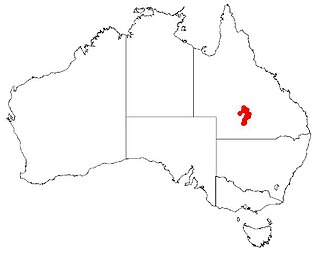
Hakea maconochieana is a shrub in the family Proteacea and is endemic to Queensland Australia. It is a rare species with red flowers, needle-like leaves and an upright or spreading shrub.
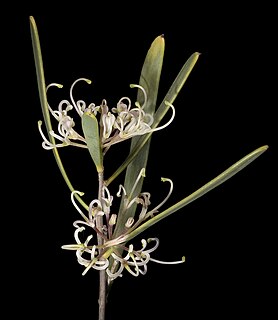
Hakea stenophylla is a shrub or tree in the family Proteacea, with sweetly scented creamy-white flowers. It is endemic to Western Australia.

Rubus tricolor is an evergreen prostrate shrub, native to southwestern China. Leaves are dark green above, pale green below, and stems have red bristles. It has white flowers in summer, and edible red fruit. It grows approximately 0.3 m (1 ft) high and usually forming a vigorously spreading, dense mat. In cultivation it is mainly used as groundcover. Common names include Chinese bramble, groundcover bramble, creeping bramble, Korean raspberry, Himalayan bramble, Groundcover Raspberry. In Chinese it is called 三色莓.

Vexatorella obtusata is an evergreen shrub, with narrow, leathery leaves and about 2 cm big, globular flowerheads consisting of well scented, creamy pink flowers, from which a long style with a thickened tip extends. Two subspecies are distinguished, both restricted to different parts of the Western Cape province of South Africa. The creeping V. obtusata subsp. obtusata, also known as the Montagu vexator flowers from September to December, and the upright V. obtusata subsp. albomontana, also known as the Witteberg vexator, that has flowers between August and November.






















